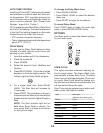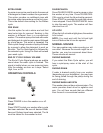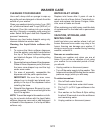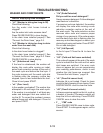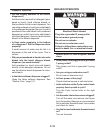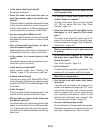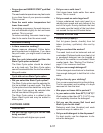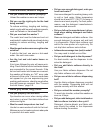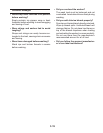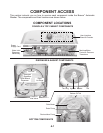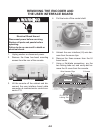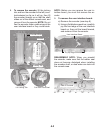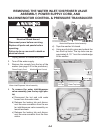
3-17
Do you have an ENERGY STAR
®
qualified
washer?
The wash water temperatures may feel cooler
to you than those of your previous washer.
This is normal.
Does the wash water temperature feel
lower than usual?
As washing progresses, the wash tempera-
ture will decrease slightly for hot and warm
washes. This is normal.
To reduce wrinkling, the warm rinse is regu
-
lated to be cooler than the warm wash.
Excessive sudsing
Is there excessive sudsing?
Always measure detergent. Follow deter-
gent manufacturer’s directions. If you have
very soft water, you might need to use less
detergent.
Was the cycle interrupted and then the
Stain Cycle option selected?
The Stain Cycle option should be started
on a dry load only. The Stain Cycle option
cannot be selected after the tub has started
filling with water.
Cycle did not run Stain Cycle option
Did you select the Stain Cycle option?
The Stain Cycle option must be selected for
it to be included in a wash cycle. The Stain
Cycle option should be started on a dry load
only. Stain Cycle cannot be selected after
the tub has started filling with water.
The Stain Cycle option is a default in the
Super Wash cycle and may be added to
other cycles.
CLOTHING CARE
Load too wet
Did you use the right cycle for the load
being washed?
Select a cycle with higher spin speed.
•
•
•
•
•
•
Did you use a cold rinse?
Cold rinses leave loads wetter than warm
rinses. This is normal.
Did you wash an extra large load?
A large unbalanced load could result in a
reduced spin speed and wet clothes at the
end of the cycle. Evenly distribute the load
and make sure the height of the load does
not exceed the top row of basket holes.
Residue or lint on load
Did you sort properly?
Sort lint givers (towels, chenille) from lint
takers (corduroy, synthetics). Also sort by
color.
Did you overload the washer?
The wash load must be balanced and not
overloaded. Clothes should move freely. Lint
or powdered detergent can be trapped in
the load if the washer is overloaded. Wash
smaller loads. See “Starting The Washer,”
page 3-3 for maximum load size.
Did you use enough detergent?
Follow detergent manufacturer’s directions.
Use enough detergent to hold the lint in the
water.
Did you line dry your clothing?
If so, you can expect some lint on the clothing.
The air movement and tumbling of a dryer
removes lint from the load.
Was paper or tissue left in pockets?
Is your water colder than 60°F (15.6°C)?
Wash water colder than 60°F (15.6°C) may
not completely dissolve the detergent.
Did you use the proper Soil Level and
Wash Cycle for the load?
Reducing wash time (duration) and wash
speed are ways to reduce lint.
Did you add detergent to the dispenser?
For best results, use the dispenser to dis
-
solve the detergent.
•
•
•
•
•
•
•
•
•
•



